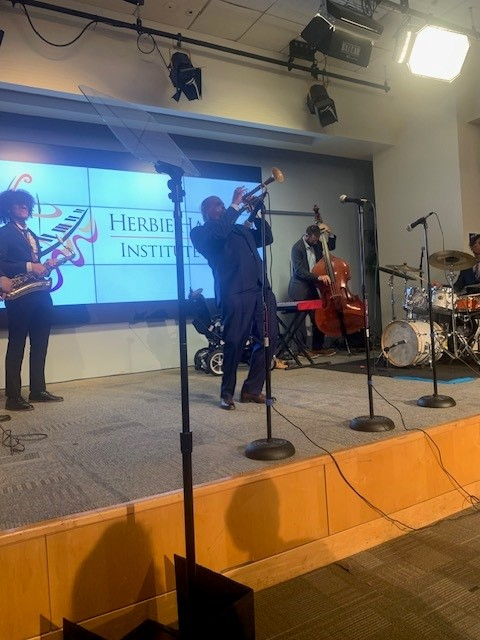On April 10, the magic of jazz, teaching, learning, improvisation, individuality, and teamwork came together in the DC. On that day, the U.S. Department of Education (ED) enthusiastically co-hosted its annual "Jazz Informance" (a mix of performance and jazz teaching and learning) in collaboration with the Herbie Hancock institute of Jazz (HHIJ). Along with the work of that day, came some cool jazz from the Institute’s Peer-to-Peer Jazz Quintet. four of the most gifted and talented high school jazz students from performing arts schools in DC, Baltimore, and NYC, along with a gifted music teacher from the Baltimore School for the Arts, and an off-the-charts, very talented jazz trumpeter, recording artist and educator Sean Jones.
The students were: Quinn Rehkemper, alto saxophone, senior—Baltimore School for the Arts; Ben Sherman, tenor saxophone, senior—LaGuardia High School of Music & Art and Performing Arts; José André Montano, piano, senior—Duke Ellington School of the Arts; and Julian Frazier, drums, senior—Baltimore School for the Arts. The teacher was Ed Hrybyk, bass, Director of Jazz Studies—Baltimore School for the Arts. They played flawlessly the carefully-curated works of Wayne Shorter. Herbie Hancock, Charlie Parker, Kenny Durham, and Dizzy Gillespie.
Maureen Dowling of ED and the Deputy Secretary of Education, Cindy Marten (who was hosting a very special guest—her mother, who was celebrating a birthday), introduced the program, and Dr. J.B. Dyas from the HHIJ, a gifted jazz educator (along with the performers), gave a creative lesson to the audience making the complexities of jazz simple and understandable, and showing what really makes jazz the magic that it is. I had the honor of giving short closing remarks about the connections between the lessons of jazz and good teaching, and I also read a poem from a collaboration of authors that I will leave anonymous for now (but I identify in the video linked below).
In a packed Education Department auditorium of students and their teachers from around the DC area, and ED colleagues (with an online audience watching as well), we became part of a joyful and soulful celebration of spontaneity, risk-taking, individuality, collaboration, resilience, teamwork, trust, and freedom that exemplify the American spirit, the principles of leadership, and good teaching at its finest. On this day, at ED. history was created before our eyes and ears, and classics were remade in honor of this special occasion.
When responding to audience questions, the students were as articulate and thoughtful with words as they were with their music. If you ever doubted that students of all ages can learn, that good teachers can teach even the most difficult of subjects, and that people of all views and backgrounds can get engaged and emerge from their comfort zones to take a risk, and collaborate for the greater good, your doubts were put to rest in ninety bar-raising minutes.
The power of music to influence thinking skills, the power of teaching and learning, the power of being open to new views and ideas, the power of taking risks and learning from the mistakes that might come, all came together through the sounds and the words of a diverse team of gifted. yet humble student musicians and teachers, playing with an experienced virtuoso.
This was truly a lesson and an experience for the ages during Jazz Appreciation Month, and was a great prelude to International Jazz Day, which is commemorated on April 30.
I invite you to watch the event video for the full experience at:
https://www.youtube.com/watch?v=d73zwuzhryc
Enjoy, but please feel no pressure to watch.









